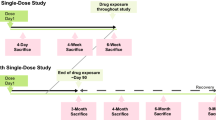Abstract
We have recently demonstrated that intra-articular (IA) administration of human recombinant lubricin, LUB:1, significantly inhibited cartilage degeneration and pain in the rat meniscal tear model of post-traumatic arthritis. In this report, we show that after a single IA injection to naïve rats and rats that underwent unilateral meniscal tear, [125I]LUB:1 had a tri-phasic disposition profile, with the alpha, beta, and gamma half-life estimates of 4.5 h, 1.5 days, and 2.1 weeks, respectively. We hypothesize that the terminal phase kinetics was related to [125I]LUB:1 binding to its ligands. [125I]LUB:1 was detected on articular cartilage surfaces as long as 28 days after single IA injection. Micro-autoradiography analysis suggested that [125I]LUB:1 tended to localize to damaged joint surfaces in rats with meniscal tear. After a single intravenous (IV) dose to rats, [125I]LUB:1 was eliminated rapidly from the systemic circulation, with a mean total body clearance of 154 mL/h/kg and a mean elimination half-life (t 1/2) of 6.7 h. Overall, LUB:1 has met a desired disposition profile of a potential therapeutic intended for an IA administration: target tissue (knee) retention and fast elimination from the systemic circulation after a single IA or IV dose.




Similar content being viewed by others
References
Elsaid KA, Jay GD, Warman ML, Rhee DK, Chichester CO. Association of articular cartilage degradation and loss of boundary-lubricating ability of synovial fluid following injury and inflammatory arthritis. Arthritis Rheum. 2005;52(6):1746–55.
Rhee DK, Marcelino J, Baker M, Gong Y, Smits P, Lefebvre V, et al. The secreted glycoprotein lubricin protects cartilage surfaces and inhibits synovial cell overgrowth. J Clin Invest. 2005;115(3):622–31.
Schumacher BL, Hughes CE, Kuettner KE, Caterson B, Aydelotte MB. Immunodetection and partial cDNA sequence of the proteoglycan, superficial zone protein, synthesized by cells lining synovial joints. J Orthop Res. 1999;17(1):110–20.
Su JL, Schumacher BL, Lindley KM, Soloveychik V, Burkhart W, Triantafillou JA, et al. Detection of superficial zone protein in human and animal body fluids by cross-species monoclonal antibodies specific to superficial zone protein. Hybridoma. 2001;20(3):149–57.
Teeple E, Elsaid KA, Fleming BC, Jay GD, Aslani K, Crisco JJ, et al. Coefficients of friction, lubricin, and cartilage damage in the anterior cruciate ligament-deficient guinea pig knee. J Orthop Res. 2008;26(2):231–7.
Young AA, McLennan S, Smith MM, Smith SM, Cake MA, Read RA, et al. Proteoglycan 4 downregulation in a sheep meniscectomy model of early osteoarthritis. Arthritis res therapy. 2006;8(2):R41.
Marcelino J, Carpten JD, Suwairi WM, Gutierrez OM, Schwartz S, Robbins C, et al. CACP, encoding a secreted proteoglycan, is mutated in camptodactyly–arthropathy–coxa vara–pericarditis syndrome. Nat Genet. 1999;23(3):319–22.
Catterall JB, Stabler TV, Flannery CR, Kraus VB. Changes in serum and synovial fluid biomarkers after acute injury (NCT00332254). Arthritis res therapy. 2010;12(6):R229.
Elsaid KA, Fleming BC, Oksendahl HL, Machan JT, Fadale PD, Hulstyn MJ, et al. Decreased lubricin concentrations and markers of joint inflammation in the synovial fluid of patients with anterior cruciate ligament injury. Arthritis Rheum. 2008;58(6):1707–15.
Zhang D, Johnson LJ, Hsu HP, Spector M. Cartilaginous deposits in subchondral bone in regions of exposed bone in osteoarthritis of the human knee: histomorphometric study of PRG4 distribution in osteoarthritic cartilage. J Orthop Res. 2007;25(7):873–83.
Jones AR, Gleghorn JP, Hughes CE, Fitz LJ, Zollner R, Wainwright SD, et al. Binding and localization of recombinant lubricin to articular cartilage surfaces. J Orthop Res. 2007;25(3):283–92.
Flannery et al. 56th Annual Meeting of the Orthopedic Research Society. 2010: Paper 164.
Flannery CR, Zollner R, Corcoran C, Jones AR, Root A, Rivera-Bermudez MA, et al. Prevention of cartilage degeneration in a rat model of osteoarthritis by intraarticular treatment with recombinant lubricin. Arthritis Rheum. 2009;60(3):840–7.
Jay GD, Fleming BC, Watkins BA, McHugh KA, Anderson SC, Zhang LX, et al. Prevention of cartilage degeneration and restoration of chondroprotection by lubricin tribosupplementation in the rat following anterior cruciate ligament transection. Arthritis Rheum. 2010;62(8):2382–91.
Teeple E, Elsaid KA, Jay GD, Zhang L, Badger GJ, Akelman M, et al. Effects of supplemental intra-articular lubricin and hyaluronic acid on the progression of posttraumatic arthritis in the anterior cruciate ligament-deficient rat knee. Am J Sports Med. 2011;39(1):164–72.
Vugmeyster Y, DeFranco D, Szklut P, Wang Q, Xu X. Biodistribution of [125I]-labeled therapeutic proteins: application in protein drug development beyond oncology. J Pharm Sci. 2010;99(2):1028–45.
Janusz MJ, Bendele AM, Brown KK, Taiwo YO, Hsieh L, Heitmeyer SA. Induction of osteoarthritis in the rat by surgical tear of the meniscus: inhibition of joint damage by a matrix metalloproteinase inhibitor. Osteoarthr Cartil. 2002;10(10):785–91.
Moore EE, Bendele AM, Thompson DL, Littau A, Waggie KS, Reardon B, et al. Fibroblast growth factor-18 stimulates chondrogenesis and cartilage repair in a rat model of injury-induced osteoarthritis. Osteoarthr Cartil. 2005;13(7):623–31.
Nemirovskiy O, Zheng YJ, Tung D, Korniski B, Settle S, Skepner A, et al. Pharmacokinetic/pharmacodynamic (PK/PD) differentiation of native and PEGylated recombinant human growth hormone (rhGH and PEG-rhGH) in the rat model of osteoarthritis. Xenobiotica foreign comp biol sys. 2010;40(8):586–92.
Lindqvist U, Tolmachev V, Kairemo K, Astrom G, Jonsson E, Lundqvist H. Elimination of stabilised hyaluronan from the knee joint in healthy men. Clin Pharmacokinet. 2002;41(8):603–13.
Findlay DM. If good things come from above, do bad things come from below? Arthritis res therapy. 2010;12(3):119.
Navarro-Sarabia F, Coronel P, Collantes E, Navarro FJ, Rodriguez de la Serna A, Naranjo A, et al. A 40-month multicentre, randomised placebo-controlled study to assess the efficacy and carry-over effect of repeated intra-articular injections of hyaluronic acid in knee osteoarthritis: the AMELIA project. Annals of the rheumatic diseases. 2011 Aug 17.
Acknowledgments
Authors thank David Defranco, Jennifer Spencer-Pierce, Cyndi Filliettaz, Adam Root, Tracey Blanchet, Vikram Patel, and Sonya Glasson for their assistance with these studies.
Author information
Authors and Affiliations
Corresponding author
Rights and permissions
About this article
Cite this article
Vugmeyster, Y., Wang, Q., Xu, X. et al. Disposition of Human Recombinant Lubricin in Naive Rats and in a Rat Model of Post-traumatic Arthritis After Intra-articular or Intravenous Administration. AAPS J 14, 97–104 (2012). https://doi.org/10.1208/s12248-011-9315-4
Received:
Accepted:
Published:
Issue Date:
DOI: https://doi.org/10.1208/s12248-011-9315-4




